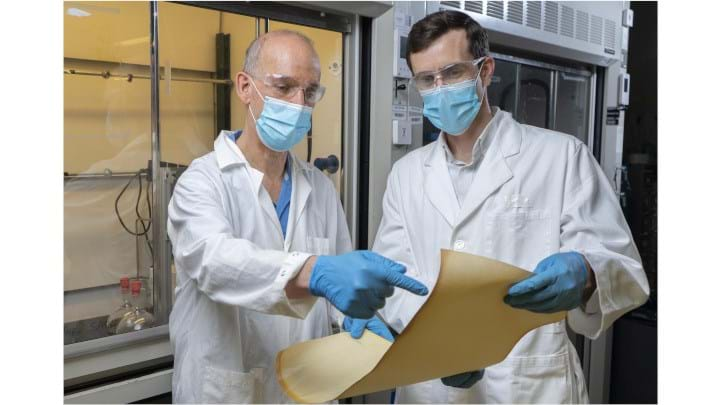Novel membrane for crude oil fractionation

AN INTERNATIONAL research team has developed new membrane technology that could reduce carbon emissions and energy intensity associated with crude oil refining. According to the researchers, the developed membrane is believed to be the first reported synthetic membrane specifically designed to separate crude oil and crude-oil fractions.
Crude oil fractionation is typically achieved through heat-based distillation. The process is large-scale and energy-intensive, and accounts for nearly 1% of global energy use – 1,100 TWh/y – according to the researchers. Membrane-based separation offers the potential to reduce the energy intensity of thermal separation, however the complexity of refining has thus far limited the use of membranes.
By substituting low-energy membranes for certain steps in the distillation process, new technology could one day allow implementation of hybrid refining systems which could significantly reduce carbon emissions and energy consumption.
ExxonMobil assembled a team which includes researchers from ExxonMobil, Georgia Institute of Technology, US, and Imperial College London, UK. The researchers overcame existing limitations by developing a novel spirocyclic polymer to create membranes capable of separating complex hydrocarbon mixtures through the application of pressure rather than heat.
Using one of the polymer membranes, named SBAD-1, the researchers were able to fraction a real shale-based light whole crude oil at 130oC with an applied pressure of 5.5 MPa.
Following separation, the crude oil was enriched with 60% hydrocarbons lighter than 170 Da corresponding to a carbon number of 12 (C12) or a boiling point of less than 200oC. A dalton, or Da, is a unit of mass equal to exactly 1/12th the mass of a carbon-12 atom. The 60% enrichment was an increase from 38% enrichment in the feed. Andrew Livingston, Professor of Chemical Engineering at Imperial, explained that that this degree of separation could be employed in a hybrid membrane-distillation process, involving multiple membrane separations, to reduce energy consumption.
The separation ability of the developed membranes demonstrates selectivity for molecules in the naphtha (C5–12) and early kerosene (C10–C18) boiling range. The naphtha and kerosene fractions of crude oil make up the primary components of gasoline and jet fuel, respectively. The fractions typically contain hydrocarbons with boiling points ranging from 90 oC–300 oC , making them a good candidate for membrane-based hydrocarbon fractionation.
Full separation of the fractions would require repeated membrane stages in a membrane cascade, explained Livingston.
The researchers discovered that SBAD-1 has a low permeance of 0.016 L/m2/hour/bar which is at the lower end of what is commercially viable. However, the permeance was achieved with films of around 0.5–1.0 micron thickness, and it could be increased by optimising the fabrication process to produce thinner films.
The polymer membrane was discovered to have a molecular weight cutoff of about 253 g/mol, and could achieve separations of molecules in the 100–350 g/mol range. Most other membranes operating in similar regimes require post-polymerisation or post-fabrication modifications, which can be costly and difficult to scale up. The polymers used in this study can be tailored with simple changes in composition and performance.
According to the researchers, the properties of the SBAD family make it promising for the separation of small-sized molecules in complex mixtures such as crude regimes. However, further work is needed to optimise the methods for synthesising the polymer to improve the permeance while maintaining selectivity, said Livingston. He added that the research team is currently “continuing work into further developments across the field of polymer chemistry, materials science, and separations engineering”.
MG Finn, Professor and Chair of Georgia Tech’s School of Chemistry and Biochemistry said: “Much in our modern lives comes from oil, so the separation of these molecules makes our modern civilisation possible.
“The scale of the separation required to provide the products we use is incredibly large. This membrane technology could make a significant impact on global energy consumption and the resulting emissions of petroleum processing.”
Livingston commented: “Chemical engineering has been hugely influenced, perhaps to some extent defined, by the development of distillation. With these membranes, we hope to stimulate a re-think of business-as-usual in the field of molecular separation – but we need help to innovate and hope chemical engineers will take up the challenge with us to imagine and create new, low energy routes to the materials society needs.”
The researchers worked collaboratively, with the polymer being designed and tested at Georgia Tech, then converted into 200 nm thick films, and incorporated into membrane modules at Imperial. Samples were tested at all three organisations involved in the research, providing multi-lab confirmation of the membrane capabilities.
Science: https://bit.ly/3h43mO4
Recent Editions
Catch up on the latest news, views and jobs from The Chemical Engineer. Below are the four latest issues. View a wider selection of the archive from within the Magazine section of this site.




